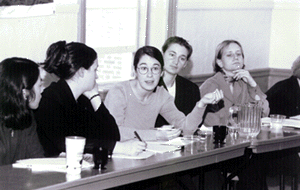|
|
Strategies For Revitalizing BaltimoreBy Glenn SmallHomewood |

Baltimore City could benefit from several revitalization strategies if policymakers are wise in selecting the best of several approaches, and if the city makes efforts to improve its data on neighborhoods, a group of students in the Master of Arts in Policy Studies program concluded.
The students presented their findings last week to a standing-room-only audience of politicians, planners, community activists and researchers, after a 13-week intensive study of Baltimore and how the city might benefit from five urban revitalization strategies that have generated considerable attention over the last decade.
 |
| Students Jennifer Kang, Emily Rowe, Erika Weissinger, Sue Peters and Katie Krile participate in a briefing on strategies to revitalize the city, part of their Introduction to Policy Analysis course. |
The presentation, attended by City Council members and city planners, has become an annual feature for first-year students in the Institute for Policy Studies' Master of Arts in Policy Studies program, said Sandra J. Newman, interim director of IPS. Newman assigned the students the Baltimore project as part of a core course, Introduction to Policy Analysis.
The students were asked to closely examine five highly touted urban revitalization strategies and apply them to Baltimore. Among those examined were the efforts in New York's South Bronx, where more than 10,000 housing units have been built in recent years as part of a long-term revitalization effort; neighborhood triage, where a medical analogy is used to represent an effort to direct multiple resources at urban areas that are borderline but "salvageable"; the Porter Model, which argues that to successfully revitalize urban areas cities should attract business and development; and regionalism, where cities
craft closer ties with surrounding communities to share resources and to work cooperatively.
"I think as a first-semester group of graduate students, given this project, they certainly put forth a valiant effort to look at the concerns we're faced with in the city of Baltimore," said Councilwoman Helen Holton, 5th District, and a graduate of Hopkins. "I think it was a good presentation. It was comprehensive."
Baltimore, the students found, is a city on a slow decline, where middle-class flight has continued for decades, the population has declined along with the housing stock and poverty levels exceed the national average. It's a city with a low high-school graduation rate and where 36 percent of public schools are in poor condition; it is also a jurisdiction that faces a continued financial crisis.
After reviewing the revitalization strategies, the students concluded that in many cases Baltimore also suffers from a lack of hard data with which to evaluate whether such models might or might not work here. With the city's first comprehensive plan in 30 years currently under way, some of the students' findings and suggestions may be used by city officials. It's happened before. "We are gratified to learn that some of our past reports have been used by policymakers and citizens," Newman said.
The 19 students are in the process of preparing a final report, which will be published in the institute's Occasional Paper Series. Newman said she expects it to be available in February.
After their presentation on Dec. 8, the students fielded questions from City Council members and others in the audience.
"I think they did a tremendous job," Newman said. "I was very pleased." But more importantly, their work attracted a broad and diverse audience and generated a solid, substantive discussion of the issues. These are two of my goals in assigning a Baltimore project each year."
The students concluded that there was an "inordinate absence of data" on Baltimore neighborhoods, which prevented them from making a more sophisticated analysis of how some of the revitalization strategies might play out in Baltimore.
One of the first recommendations: develop better data at the neighborhood level.
After studying how other cities used the urban revitalization strategies, the students offered some lessons. Many of these strategies that worked had strong visionary leaders, strong political and financial support from city and often state government, energetic lead organizations and competent technical assistance, they said.
Baltimore could benefit from more regional cooperation, such as tax base sharing between Baltimore and its surrounding communities. Although it is commonly understood that such cooperation requires consensus building, the students said it is rarely acknowledged that the prime examples of regional cooperation--Portland, Ore., and Minneapolis--evolved over 30 years or more.
The South Bronx experience suggests that a visible entry point could make a difference. In Baltimore, this could take the form of revitalizing the deteriorating stock of public facilities, including schools.
| GO TO DECEMBER 14, 1998 TABLE OF CONTENTS. |
| GO TO THE GAZETTE HOMEPAGE. |